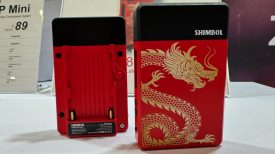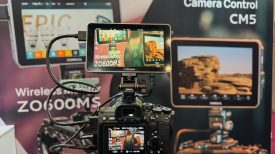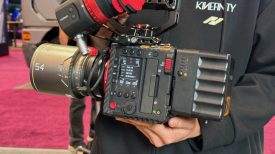By Ahmed Elhusseiny
Every year, somewhere in the middle of the Black Rock Desert in Nevada, a diverse and motley group of people from around the globe gather for the annual counterculture arts festival-cum-social experiment known as Burning Man.
I had heard stories about the festival and bits and pieces from friends and had seen enough images of the event to have some general idea of the aesthetic of the place. It was really that aesthetic rather than any kind of experiential or narrative aspect that was for me, the primary draw. Here was an entire city full of extravagant set pieces, whimsical vehicles, and fully costumed extras, set down in the middle of an almost otherworldly desert landscape that only magnified the surreal characteristics of the entire scene – all just waiting to be filmed.
When a chance arose to attend last year’s “Burn” the prospect was too good to pass up.
Technically it wasn’t the easiest shoot to plan. For starters, let’s talk about dust. Not just any dust, but the finest, highly alkaline powder that I have ever seen (and having grown up in Egypt, believe me I’ve seen my share of dust and sand). I knew that there was no way I would be changing lenses outdoors. The “playa dust” got absolutely everywhere, and I was already placing quite a bit of (well justified, it turns out) trust in my Canon 7D weather seals. What this meant was that I would usually choose a lens and use it all day. If I came across a shot that I felt required a different lens, I would take a mental note of it and hope that it was still there when I came back the next day. I did lose a few potentially good shots that way, but I was able to capture a great deal more and still have a functioning camera at the end of the trip to boot so I think it was a fair trade-off.
Shooting at night was another technical challenge. I love my 7D dearly but there were times when I was shooting at night that I would have sold an arm and a leg (preferably not my own) for a 5D mkII with better low-light performance. First to be sacrificed to the light sensitivity gods was the 60fps I had been shooting at. I needed every split second of shutter speed so it was down to 24fps. Next was going wide open when I could, and when I needed more than a few hairs’ width of depth of field I had to crank up the ISO all the way to 6400 on some shots. This obviously resulted in a lot of noise and a surprising amount of compression artifacting. I was able to use some of the most affected shots only after running them through Neat Video’s denoise plug-in for After Effects. I had never used an external denoise plug-in before but it was pretty phenomenal. Shots that I had completely given up on ended up becoming more than usable. One shot that was beyond salvage took place just before the Trojan horse burn and involved convincing the crew (all actual, real life fishermen) of a New England lobster boat turned mutant desert vehicle, to let me climb up the ship’s 60ft mast to film the scene from above. I’m afraid the violent swaying of the boat due to the all the revellers dancing on the decks below, coupled with the difficulty of filming with one hand while holding on for dear life with the other, meant that the resulting footage was a blurry, shaky, unsalvageable mess. I wonder if an IS lens along with generous cleaning up/stabilization in post could have saved the day? A question for another shoot I guess.
It turned out that the biggest challenges, however, were not technical at all but more a byproduct of the eclectic and unpredictable nature of the subject matter. This may seem elementary but context, exposition, pacing and framing the subject become even more critical when the subject matter is so surreal and disconnected from anything that we can easily associate with a cognitive benchmark. The temptation to try to match the exuberance of all the weird and wonderful structures, contraptions and costumes with “enthusiastic” camera motion and trick editing is a common pitfall that I recognized in a great deal of the videos I had seen of earlier Burns, and one that I made a conscious decision early on to avoid.
Both parts but “Day” in particular were very deliberately paced to allow the viewer to gradually settle into the atmosphere. Wide shots were used extensively to convey the sheer scale of the city within the desert before transitioning to tighter, more carefully composed compositions where careful layering of foreground and background along simple horizontal motion provided much of the visual interest. The ever-present cloud of dust at eye level also enabled a wonderful degree of separation between visual planes that added greatly to the sense of depth in many of the shots even when filmed with small aperture openings and a significant amount of depth of field.
I ended up with two very different videos for “Night” and “Day” and not just for the obvious reasons. “Day” was much more structured, controlled and restrained. In my view it has a more architectural quality to it that makes it the more successful of the two. Others have told me that they preferred “Night” and it is certainly the more vivid, warmer, and more familiarly “human”. Ultimately, I’m happy I had the chance to finally experience the event in person and come away with a short, personal document of my time there.
Ahmed Elhusseiny is a Brooklyn, New York based Designer, Architect, Photographer, and Filmmaker. You can find out more about his work on his website.






